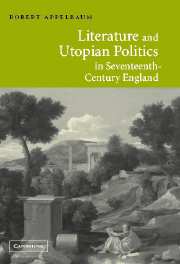Book contents
- Frontmatter
- Contents
- Acknowledgments
- Introduction
- Chapter 1 The look of power
- Chapter 2 Utopian experimentalism, 1620–1638
- Chapter 3 “Reformation” and “Desolation”: the new horizons of the 1640s
- Chapter 4 Out of the “true nothing,” 1649–1653
- Chapter 5 From constitutionalism to aestheticization, 1654–1670
- Notes
- Index
Chapter 4 - Out of the “true nothing,” 1649–1653
Published online by Cambridge University Press: 22 September 2009
- Frontmatter
- Contents
- Acknowledgments
- Introduction
- Chapter 1 The look of power
- Chapter 2 Utopian experimentalism, 1620–1638
- Chapter 3 “Reformation” and “Desolation”: the new horizons of the 1640s
- Chapter 4 Out of the “true nothing,” 1649–1653
- Chapter 5 From constitutionalism to aestheticization, 1654–1670
- Notes
- Index
Summary
RUINING THE WORK OF TIME
At the beginning of the second book in Don Quixote, Quixote is recovering from his mad adventures in Book One. He spends the time in conversation and other innocent amusements with his two friends, the barber and the priest. In the course of their dialogue, as Cervantes tells his readers, the three men
happened to discuss the principles of statecraft – as they are called – and methods of government, correcting this abuse and condemning that, reforming one custom and abolishing another, each one of the three setting himself up as a fresh lawgiver, a modern Lycurgus or a brand-new Solon. To such a degree did they refashion the commonwealth that it was if they had taken it to the forge and brought away a different one.
All three men, in a sense, are acting Quixotic here; they are dwelling on an illusion. But this is a humanist rather than a chivalrous illusion. The premise is philosophic and amelioristic rather than egoistic and nostalgic. As the novel, in its second part, is becoming more self-reflexive in its own right – commenting on its own creative machinery, putting Quixote in situations where he finds himself confronted by the effects of the fictional legacy of Book One – so it dwells momentarily on a gentle parody of humanist self-reflexivity, a discussion of the principles of statecraft.
- Type
- Chapter
- Information
- Literature and Utopian Politics in Seventeenth-Century England , pp. 140 - 171Publisher: Cambridge University PressPrint publication year: 2002



